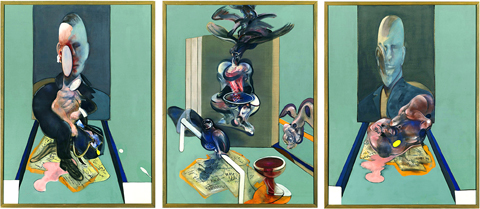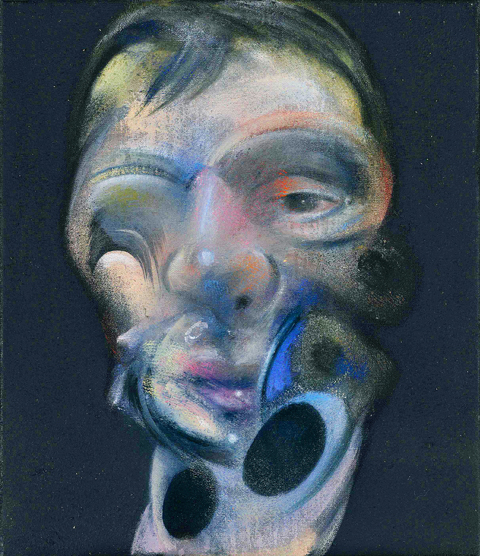A 1975 set of three self-portraits by Francis Bacon fetched US$34.5 million in London, the most expensive lot at Christie’s International sale of contemporary art.
At least four bidders competed for the 36cm-high, gray- hued oil canvases Three Studies for Self-Portrait, featuring faces that are twisted, sliced and gorged. The lot, with a presale estimate of more than US$20 million and seen in public for the first time, went to an anonymous phone bidder. The record for Bacon was set in May when Triptych, 1976, depicting a headless corpse eaten by vultures sold for US$86 million.
Christie’s 58-lot auction last night netted US$172 million, against the company’s own low estimate of US$160 million. Eighty-three percent of the lots were sold. Bacon’s piece was one of four trophy works — the other three are by Lucian Freud, Jeff Koons and Lucio Fontana — whose combined estimates represented half the auction’s value. The Bacon was the only one that sold for much more than its top estimate.

PHOTO: AP
Koons’s 3.4m-, 5cm-high chromium-steel sculpture Balloon Flower (Magenta) sold for an artist record of US$25.8 million, against a presale estimate of US$24 million. Freud’s 1980 canvas, Naked Portrait With Reflection, showing a nude model reclining on a battered sofa, sold for US$23.6 million, compared with a top estimate US$30 million.
The Bacon and the Koons were among 14 lots whose sellers received guaranteed minimum prices, according to Christie’s catalog. When auction houses guarantee items, they usually share a percentage of the amount above an agreed price; If the lot doesn’t sell, the auction house — or a third-party guarantor — pays for the work and owns it.
“When estimates are high, people won’t bid,” New York dealer Jose Mugrabi said in an interview. Mugrabi said the market was otherwise “better than ever.”

PHOTO: AP
The salesroom fell silent when Fontana’s pink canvas La Fine di Dio, expected to fetch US$16 million, failed to sell. In February, a similar Fontana work, painted in the more desirable gold, sold for a record US$20.6 million at Sotheby’s in London, against an estimate of US$8 million.
“Christie’s estimate was very aggressive,” said Heinrich zu Hohenlohe, director of the dealers Dickinson, Berlin, in an interview. “Even in the current market there is a limit.”
Damien Hirst’s 12m-wide painting,
L-Tyrosine-15N, dating from 2001, was another casualty, failing to sell against an estimate of US$4 million to US$6 million.
A work from Andy Warhol’s 1979-86 Nine Multicolored Marilyns (Reversal Series) sold to an unidentified buyer for US$8.2 million, said Christie’s. At Phillips de Pury’s contemporary-art auction the night before, another painting from the same Warhol series fetched US$5 million.
To Her Majesty, a 37-part black-and-white photographic piece on London pub life by Gilbert & George in 1973, fetched an auction record of US$3.8 million. The previous record for the duo of US$1.272 million was set in February.
“The market was waiting for a significant work by Gilbert & George like this,” said Brett Gorvy, Christie’s international co-head of contemporary art, in an interview after the sale.
According to Christie’s, 42 percent of purchases came from the UK and Europe, 48 percent from the Americas, 8 percent from Asia and 2 percent from other regions.
Prices include a buyer’s commission of 25 percent of the hammer price up to US$50,000, 20 percent of the price from US$50,000 to US$1 million, and 12 percent above US$1 million.
Estimates do not reflect commissions.
Last week, Christie’s and rival auction house Sotheby’s, which between them account for 90 percent of the global art auction market, combined for nearly US$600 million worth of impressionist and modern art sales over three days of auctions in London.

May 26 to June 1 When the Qing Dynasty first took control over many parts of Taiwan in 1684, it roughly continued the Kingdom of Tungning’s administrative borders (see below), setting up one prefecture and three counties. The actual area of control covered today’s Chiayi, Tainan and Kaohsiung. The administrative center was in Taiwan Prefecture, in today’s Tainan. But as Han settlement expanded and due to rebellions and other international incidents, the administrative units became more complex. By the time Taiwan became a province of the Qing in 1887, there were three prefectures, eleven counties, three subprefectures and one directly-administered prefecture, with

It’s an enormous dome of colorful glass, something between the Sistine Chapel and a Marc Chagall fresco. And yet, it’s just a subway station. Formosa Boulevard is the heart of Kaohsiung’s mass transit system. In metro terms, it’s modest: the only transfer station in a network with just two lines. But it’s a landmark nonetheless: a civic space that serves as much more than a point of transit. On a hot Sunday, the corridors and vast halls are filled with a market selling everything from second-hand clothes to toys and house decorations. It’s just one of the many events the station hosts,

Two moves show Taichung Mayor Lu Shiow-yen (盧秀燕) is gunning for Chinese Nationalist Party (KMT) party chair and the 2028 presidential election. Technically, these are not yet “officially” official, but by the rules of Taiwan politics, she is now on the dance floor. Earlier this month Lu confirmed in an interview in Japan’s Nikkei that she was considering running for KMT chair. This is not new news, but according to reports from her camp she previously was still considering the case for and against running. By choosing a respected, international news outlet, she declared it to the world. While the outside world

Through art and storytelling, La Benida Hui empowers children to become environmental heroes, using everything from SpongeBob to microorganisms to reimagine their relationship with nature. “I tell the students that they have superpowers. It needs to be emphasized that their choices can make a difference,” says Hui, an environmental artist and education specialist. For her second year as Badou Elementary’s artist in residence, Hui leads creative lessons on environmental protection, where students reflect on their relationship with nature and transform beach waste into artworks. Standing in lush green hills overlooking the ocean with land extending into the intertidal zone, the school in Keelung